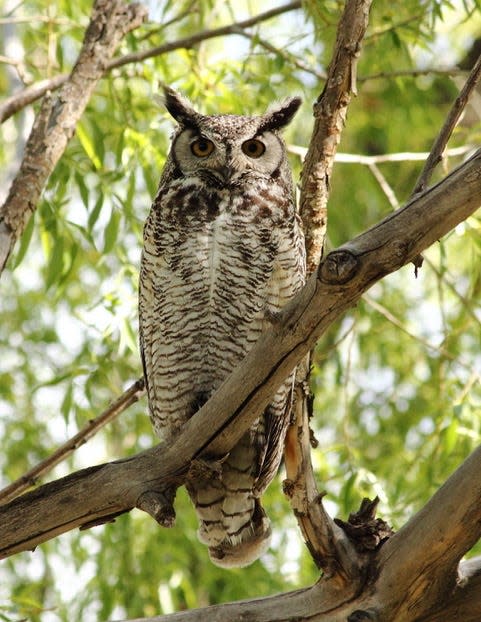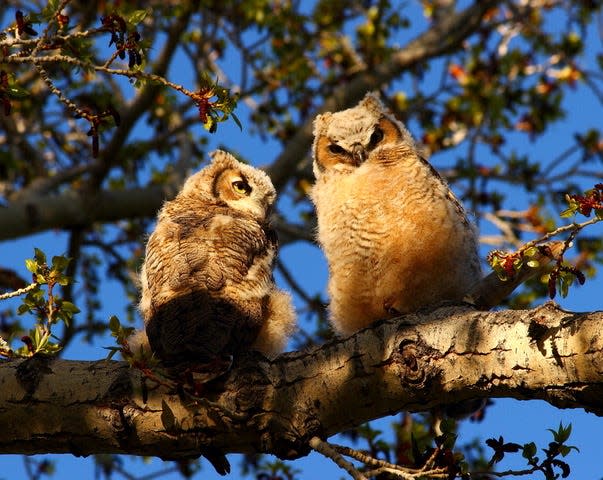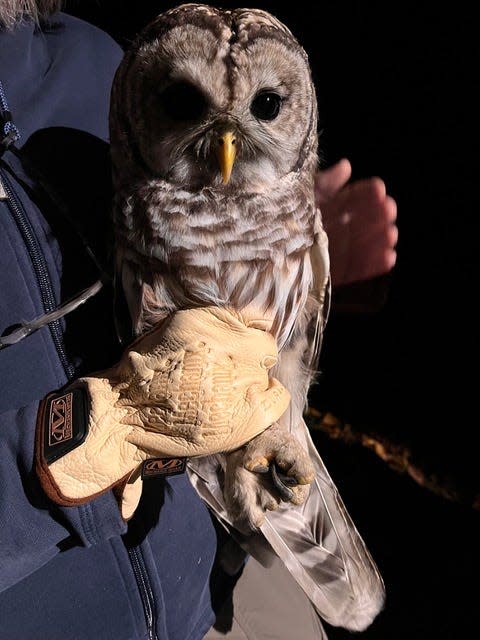There's plenty to know and find out while giving a hoot about owls

It’s 2 a.m. on Easter morning, and I’m awakened by "Hoo ho-hoo? Hoo hooo." The cadence is like, “Who’s awake? Me, too.” I open my window. The night is still. For certain, a great horned owl is calling from the Grafton Common vicinity. I hear the faint reply of a second great horned. My heart is happy.
When you see an owl, you’ll have no problem identifying it as an owl. That oversized head, those large piercing eyes, that upright, stoic stance, those cryptic feathers all indicate that you are looking at an owl. But what do we actually know about owls? How do you go about seeing an owl?
For the most part, owls are nocturnal or crepuscular. We humans are diurnal. When we’re awake, owls are asleep. Owls will announce their presence through hoots, shrieks, whistles, alarm squawks, chitters, and even delicate purring. Their language is complex and evocative. The sounds may be a territorial call, a conversation with its mate, even a calling to the owl’s youngster. Owls may well be able to recognize individuals of their species by their unique voices.
“Each individual great horned owl has a signature hoot,” Jennifer Ackerman reports in her book, "What an Owl Knows" (Penguin Press). Understanding the vocal differences of individuals has informed us that many owls do not mate for life, as was believed. A female may take on a new paramour, even while her former mate is still around.
Generally speaking, the larger the owl species, the lower and deeper its hoot. However, when a male great horned owl hoots romantically to his mate, she replies with a higher pitched hoot, due to the smaller size of her syrinx, even though she is larger than he is. He will weigh about 3½ pounds, while the female weighs up to 4½ pounds.
The great horned owl has neither horns nor large feathered ears. The erect feathers on his head help the owl blend in with the tree where he’s perched. They can also be folded down when the owl is in flight. The actual ears of the great horned are asymmetrically situated (one higher and one lower) on the sides of his head. This enables him to rely on his accurate sense of hearing when locating prey, like rats and rabbits. The beautiful, orangish, facial disc deflects sound into his ears.

Typical of all owls, the great horned will swallow his food headfirst. Later, he’ll regurgitate the undigestible parts of fur and bones into a sausage-shaped pellet. If you find one or several pellets, you’ll know where a great horned is roosting. So finding a pellet is the first way to see an owl. If you bring the pellet home and soak it in water, you’ll be able to identify its last supper by examining the bones. If you discover a white, liquidy wash dripping down the trunk of a tree, this was the waste of an owl. Look up, he may be roosting on a branch just above your head.
Owls do not build nests. That does present a difficulty when trying to find an owl. What do you look for? It’s no surprise that owls prefer to live in forests near clearings.
The great horned owl will appropriate a nest previously occupied by a great blue heron or by a hawk. A screech owl depends upon natural tree cavities in large trees. Other small owls will avail themselves of tree holes created by woodpeckers, like the pileated. Where there are no trees, like in the Arctic, the huge snowy owl will nest on the ground. The burrowing owl will borrow a burrow created by a burrowing rodent. The elf owl, our smallest, often lives in a hole in a cactus.

The great horned owl is our earliest nester, courting the female in December and January. He’ll bring her a juicy rat to prove he’s a good provider. They will duet together, touch bills, and culminate their romance with a cloacal kiss. By February, she will lay 2-3 eggs, which both parents will incubate, for about a month. Don’t ever think about getting too close to the nest. The great horned owls will defend their nest and young by swooping down upon a perceived threat with talons extended.
Since many owls, like the great horned owl, will prey on birds during the darkness of night, they are feared by songbirds. During the daytime, if an owl is discovered by a crow or a chickadee, these birds will sound the alarm, causing other birds to join in harassing the owl. Eventually, the owl is so perturbed that he is driven from his roost by the mob. If you hear this cacophony of cawing and cheeping, look about you and you just might see an owl.
One evening, last fall, while mist netting at the Mark Blazis Research Station in Auburn, we played the tape of the saw-whet’s repetitive, whistled call. Then we heard the hoots of the barred owl, which seemed to be saying, “Who cooks for you? Who cooks for you, all?” In our nets, we had trapped both the saw-whet and the barred owls. Across the pond we heard the low, deep hoot of the great horned owl. Great horneds will prey upon barreds, and barreds will prey upon saw-whets. We closed our nets early that evening to avoid predation of any sort.
—Contact Helen Blazis at MarkBlazisSafaris@gmail.com.
This article originally appeared on Telegram & Gazette: Plenty to know while giving a hoot about owls
